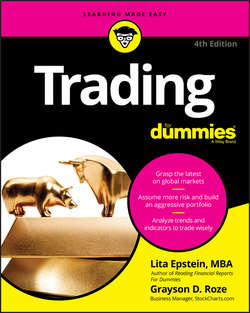Читать книгу Trading For Dummies - Lita Epstein - Страница 13
На сайте Литреса книга снята с продажи.
Part 1
Getting Started with Trading
Chapter 1
The Ups and Downs of Trading Stocks
Getting a Grip on Technical Analysis
ОглавлениеYou use fundamental analysis to determine what part of the business cycle the economy is in and what industries offer the best growth potential. Then you use that information to select the best target companies and identify prices at which you’d want to buy their stocks.
After choosing your targets, you then use technical analysis to follow trends in the prices of the target stocks so you can find the right time to get in and ultimately to get out of a stock position. These targets become part of your stock‐watch list. After you’ve established that list, you then use the tools of technical analysis to make your trades.
In Chapter 8, we introduce you to the basics of technical analysis, how it works, and how it needs to be used. Although some people think of technical analysis as no more than fortune‐telling, others believe it yields significant information that can help you make successful trades. We believe that technical analysis provides you with extensive tools for your trading success, and we show you how to use those tools to be profitable.
Your first step in technical analysis is finding out how to create a chart. We focus on the most popular type – bar charting. In Chapter 9, you discover the art of deciphering simple visual stock patterns and how to distinguish between trends and trading ranges, all so you’re able to spot when a stock moves from a trading range into either an upward or downward trend and know when you need to act.
In Chapter 10, we show you how to use your newfound skill of identifying trends to locate areas of support and resistance within a trend that ultimately help you find the right times to make your move. You find out how to read the patterns in the charts to identify trading signals and what to do whenever you’ve acted on a failed trading signal.
Chapter 11 fills you in on moving averages and how to use them to identify trends. You also find out about oscillators and other indicators that traders use for recognizing trading signals. As a newbie trader, you’ll probably find that your greatest risk is paralysis of analysis. That’s where you may find that you’re having so much fun reading the charts or are just so confused about which chart has the right signal that you feel paralyzed by the variety of choices. We show you how to create and use a tiny subset of tools that is available in today’s charting software packages to simplify your life and make your choices easier. You’ll likewise discover how to use such odd‐sounding but critical tools as an MACD indicator or a stochastic oscillator, and we help you take advantage of the powerful concept of relative strength.
